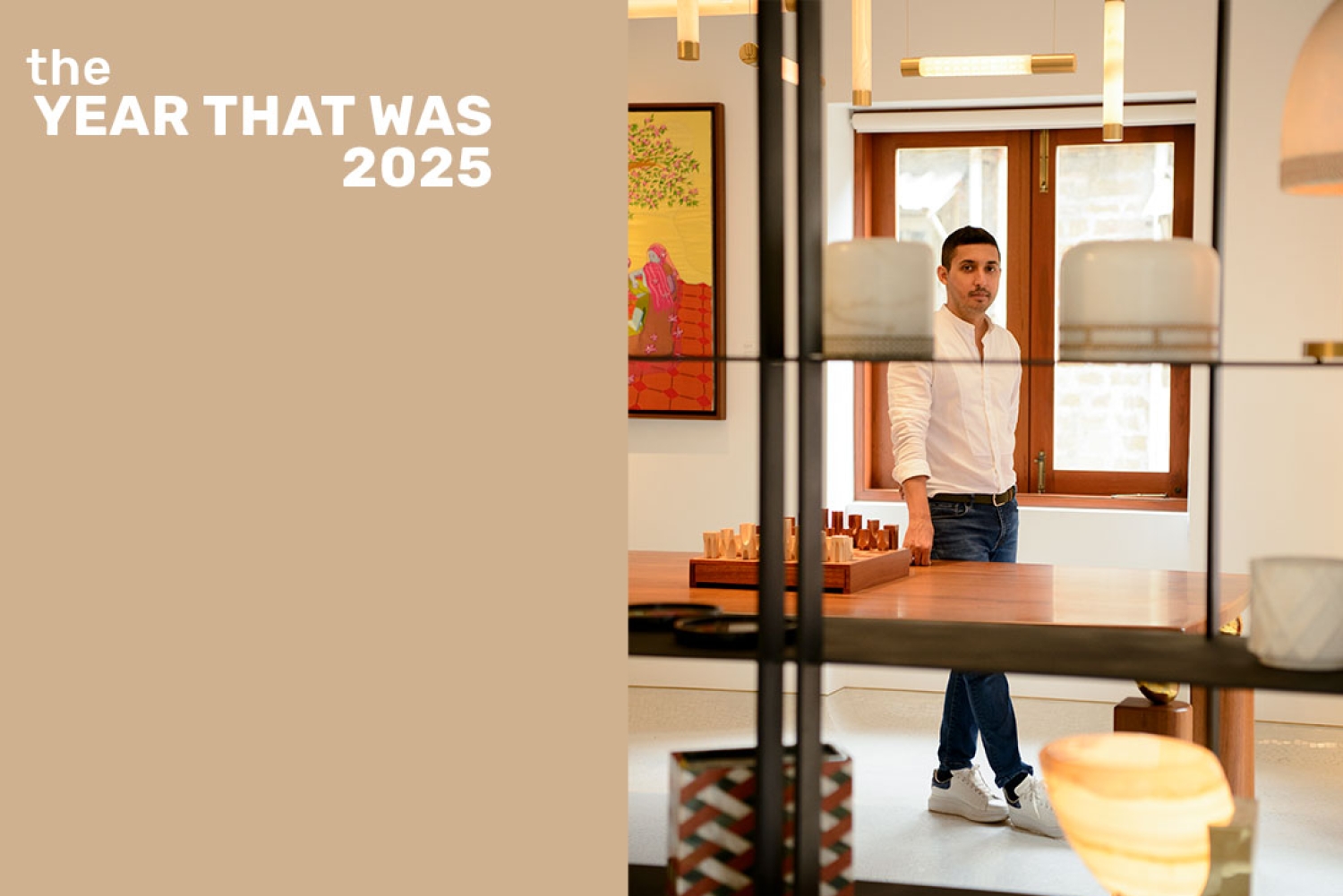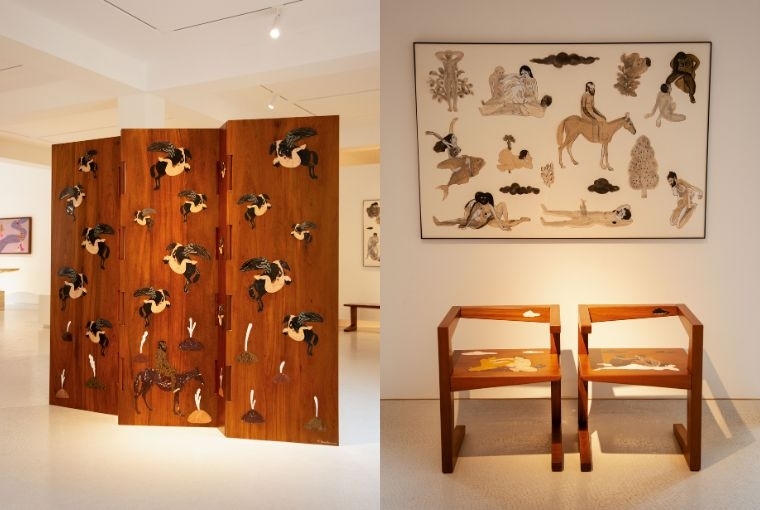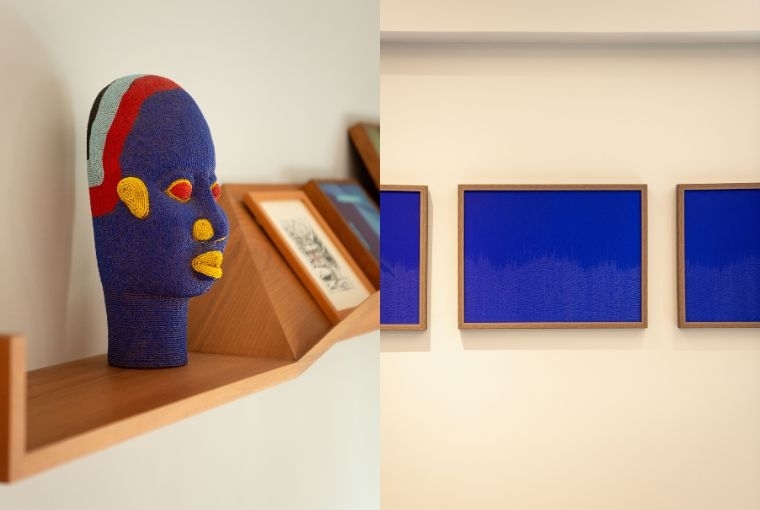

“I’ve always wanted an office in a heritage building”.
Architect-designer Rooshad Shroff’s new gallery and office, spanning seven thousand sq. feet, are cocooned within the charming Dubash House, an Edwardian neoclassical structure in Ballard Estate, Mumbai. The gallery opened this February. The building is framed by leafy boulevards, expansive banyan trees and a flourish of yellow-studded Gulmohar trees. ‘I love heritage structures—I love their craftsmanship, the high ceilings, abundance of natural light, and the quaintness of the neighbourhood,’ he continues. ‘It’s strange because, when I work, my aesthetic is much more contemporary. But for the places I want to stay or work in, I prefer something with a little more history and old-world charm’.
On the day we meet, he is dressed in his staple work attire: a crisp white shirt and a pair of blue jeans. Shroff is warm and curious, yet quietly distant. Over the years, he has steadily built a formidable repertoire. Known for his uncontrived yet unconventional design aesthetics, he has an enviable client list, which include high-end luxury brands like Hermès, Louis Vuitton, Christian Louboutin and Good Earth.
His gallery, speckled with furniture and light fixtures, holds ample natural light. I’m immediately drawn to an exquisite embroidered bench from his Weave collection, where Japanese glass beads (in hues of scarlet, antique jade and beige) have been meticulously hand-embroidered into its taut linen upholstery using the age-old aari technique. The embroidery, Shroff tells me, takes anywhere between two-thousand-five-hundred to three-thousand hours to craft. The bench, like all the other pieces in the gallery, reflects sophisticated craftsmanship.
Shroff has the predilection to find inspiration anywhere. The inspiration for the embroidered bench, for instance, can be traced to a terracotta bust-statue, fully-covered in fine, coloured beadwork—a traditional African craft which dates back to the 11th century. Almost totemic in appearance, the androgynous head has indigo blue skin, a wide set of red eyes and thick, canary-coloured lips; the back of its head is ringed by the multihued beads as well. Shroff had picked it up from one of his peripatetic travels to Morocco. ‘I saw this in the market and fell in love with it. I carried it back in my hands because it is so fragile,’ he says while picking up the head and cradling it in his arms to offer me a closer inspection. ‘I love the way the beading has been done on it. These were strung together and glued of course, but we used this as an idea to translate into an embroidered form for the bench in the Weave collection.’
A constellation of marble light bulbs, suspended from brass fixtures in his gallery, catch my eye next and I gravitate towards them. Each bulb is an exquisite work of art. Crafted from blocks of Makrana marble (the very same used to build the Taj Mahal), the bulbs bear intricate, hand-carved patterns.
Many years ago, on one of his project visits to Jaipur, Shroff found himself meandering through the inner alleyways of the old city, where he saw ‘streets and streets’ full of murti-karigars. ‘I loved the way they carved and treated the marble,’ he says, ‘almost like butter’. Shroff was fascinated by their skill, and eventually collaborated with a family of third generation Jaipuri murtikars. ‘I wanted to see how thin we could go with the marble in terms of shape. The idea of taking something as monolith as that and making it fragile, was a challenge I quite enjoyed. And, I was curious to see how light filtered through it.’ Each bulb is different from the other, carrying slight colour shifts in the stone itself—from ivory white and pale yellow to sometimes having a beautiful light-pink glow. Over forty blocks of marble were used before the karigars successfully sculpted the first hollow light bulb from a singular block of stone. Anyone familiar with the arduous process of research and development, knows the intense amount of work and materials that go into mastering the art of creating one product. But what happens to products that don’t make the cut? Where do the failed misfits go? ‘Trash,’ says Shroff with a resigned shrug. He’s not the kind who hides behind platitudes or false pretences. ‘I know that from a wastage perspective, we should be more mindful. We waste a lot. It’s not very sustainable but we are sustaining craft.’

There is truth in that, since Shroff’s practice is rooted in celebrating the handmade—each furniture piece reflects our country’s inimitable craftsmanship and artisanal wealth. In addition, he uses rescued or salvaged wood for many of his furniture pieces, including the embroidered bench which features legs made of recycled Burma teak.
He’s driven to integrate traditional handiwork with contemporary designs. It’s a consistent thread that weaves through his work—beginning with his early days of making furniture in his father’s garage, alongside two carpenters. It’s where his signature C-series came into being, a furniture collection that veers away from modern hardware and power tools, and instead opts for time-honoured craft techniques—like the dovetail joint, an age-old interlocking woodwork technique, made without nuts and bolts. The C-series went on to garner tremendous attention within the design community, and has since then evolved, leading to several iterations and creative collaborations with artists like Tanya Goel and T. Venkanna.
Within Shroff’s new office, a collection of twelve black-and-white photographs, grace a wall. Two of them feature his ‘very first piece’, the C-bench (crafted using repurposed teak) with the carpenters whom Shroff recruited in his father’s garage. ‘These are not professionally taken pictures,’ admits Shroff. ‘In fact, some of them have been taken by our karigars to show work-in-progress, and I like their rawness.’
Shroff has kept a few of his first failed pieces at his home. ‘I’ve kept my very first bench, which one can barely sit on. I still have it at home’. He has also kept his first two C-chairs, which are slightly different in proportion from the final ones. ‘In the beginning, it was nice to live with them, so that I could understand how they function and how I could improve them before they went into someone’s home.’
The documentary photographs though, serve as visual chapters or milestones, reflecting Shroff’s design trajectory—from a tight shot of a karigar’s hands carving a marble light bulb to another embroidering a wooden chair, to a bespoke furniture piece (made in collaboration with Ambrita Shahani-Tuckwell), showcasing the technique of pressed-flower découpage. ‘The Pressed-Flower collection became a popular one but we discontinued it since it was becoming too labour-intensive. We might reintroduce it at some point though.’

One of Shroff’s prized possessions, in his office, is the marble inlay plate carrying black-and-white artwork by the legendary B.V. Doshi, the first Indian architect to be honoured with the prestigious Pritzker Prize. The plate was designed as part of the Gyaan Project led by Shroff, where he reached out to twelve heavyweight architects, designers and artists, including Christian Louboutin, Sabyasachi, Abu Jani Sandeep Khosla and Atul Dodiya.
‘We requested each of them to give us a sketch, which we then translated into the marble inlay plates,’ he says. ‘They were given a set template of either a circular or square plate of eighteen inches, and then were given a colour palette of stones. Some gave a sketch, some gave us little bit more in detail, some were abstract. B.V. Doshi was really quick in giving his design. He was the easiest to work with.’ Shroff kept the artist prototype of Doshi’s plate and had gifted one to the late architect as well.
The funds raised from the auctioning of the plates in 2019, went towards the construction of The Rajkumari Ratnavati School in Jaisalmer, an educational institute for girls, in collaboration with Citta Foundation, an NGO driven towards supporting education and health of girls belonging to underprivileged homes. Shroff’s team is now working on a second edition of the series with an entirely new roster of creative masterminds.
His expansive office that houses a staff of eighteen or twenty people, also houses exquisite gems that belong to Shroff’s personal art collection, including a cerulean triptych by Waqas Khan, and a beautifully woven Alexander McQueen tapestry. His own office cabin, enclosed by floor-to-ceiling glass walls, features a small collection of tiles by ceramic artist Lubna Choudhary, a large abstract canvas by Laxman Shrestha and a sleek Paul Matter brass light with its signature glass orbs. ‘I wanted to stay away from anything I had done in my room, so I don’t even have a light which is made by me in this cabin.’
It’s his gallery that is the star of the show, though. The floor is mosaic: thousands of tiny, bone-white China tiles, painstakingly hand-laid by local women, an ode to his fascination for traditional flooring, ‘I wanted that touch of hand in our flooring as well. You’ll see them in old Parsi bungalows, but you’ll rarely find something that is done so fine,’ he notes, stating that external China mosaic is usually found in patios or terraces. Shroff, who confidently leans into his perfectionist nature, had the flooring done twice, relentlessly refining it until it met his exacting standards. ‘I wanted it to be perfectly levelled. It’s not the most practical flooring, but I’m not one for practicality.’ Shroff didn’t want the floor to be overpowering, which explains its subtle monochromatic allure.
Right beneath the suspended marble lights, sits a soft salmon pink onyx console table which belongs to Shroff’s latest Balance collection. ‘This is my favourite piece from this collection,’ he confides. The console appears to be, ironically, on the verge of an ungainly topple due to its asymmetric posture, but it’s truly a statement piece of graceful stability. Shroff and his team looked at several images of pebbles that are precariously stacked, in natural formation, on top of each other in nature, to come up with this final design. ‘The idea was to make it look like the centre of gravity is shifting. That’s the recurring theme in this collection: everything looks unstable,’ says Shroff, before stating in jest, ‘It’s probably my own brain that is unstable’.
“I wanted it to be perfectly levelled. It’s not the most practical flooring, but I’m not one for practicality.”
Each spherical component in the console is hewed from the same block, except for the table top. ‘While they are different pieces, the grain structure and quality of the marble is the same. This is also the first time we’ve worked with metal casting,’ he explains, bending slightly to show the white bronze underlay. The collection also features coffee tables, cashmere sofas, lamps and wall mirrors.
Each piece produced in his studio is marked by the eponymous logo, which as Shroff explains, ‘is half of my actual signature. I’ve removed one or two strokes, and then stylised it a little bit’. The logo too, has a story. Many years ago, when Shroff used to have long family lunches at Ripon club in Fort. ‘There was a chap who had a small stall on the footpath, where he used to make key chains, cut from metal and I thought at that time, “I’ll get my signature cut in brass from him”, and I got him to do that, which now comes on every single piece’. Today, the same fellow is responsible for working on all Shroff’s brass works. ‘He doesn’t sit on the footpath anymore. In fact, he has his own nice unit now… I want to cultivate people and teams like that’.
Shroff is now gearing towards meeting the deadline for fashion designer Rahul Mishra’s flagship store in Kala Ghoda, which opens in May and is also in the middle of designing a few private homes. ‘Our clientele is a small pool of recurring people, which is our biggest compliment,’ he shares. ‘And, I want to continue doing things that I love and take on projects that I love’.
Words Radhika Iyengar
Photography Karan Kumar Sachdev
Date 9-08-2025